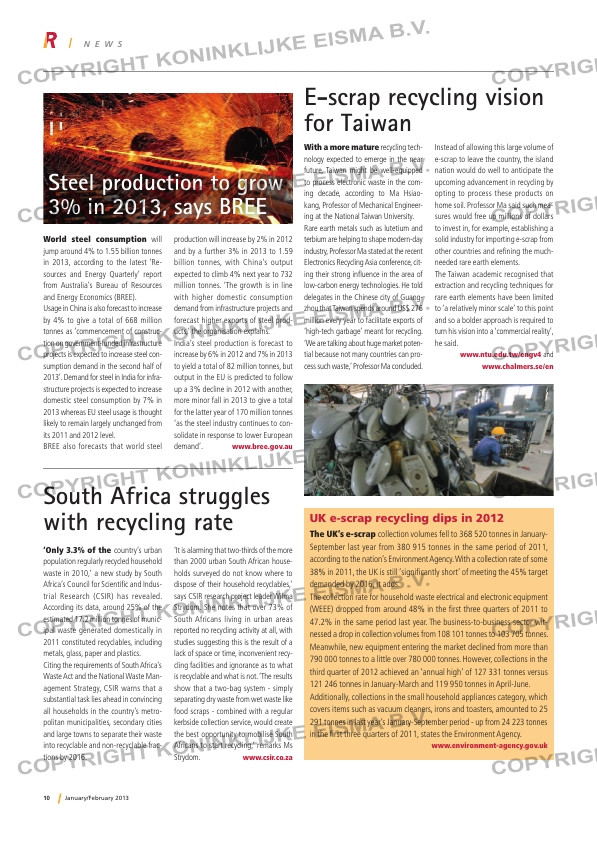Page 10 from: January / February 2013

10 January/February 2013
N E W S
World steel consumption will
jump around 4% to 1.55 billion tonnes
in 2013, according to the latest ‘Re-
sources and Energy Quarterly’ report
from Australia’s Bureau of Resources
and Energy Economics (BREE).
Usage in China is also forecast to increase
by 4% to give a total of 668 million
tonnes as ‘commencement of construc-
tion on government-funded infrastructure
projects is expected to increase steel con-
sumption demand in the second half of
2013’. Demand for steel in India for infra-
structure projects is expected to increase
domestic steel consumption by 7% in
2013 whereas EU steel usage is thought
likely to remain largely unchanged from
its 2011 and 2012 level.
BREE also forecasts that world steel
production will increase by 2% in 2012
and by a further 3% in 2013 to 1.59
billion tonnes, with China’s output
expected to climb 4% next year to 732
million tonnes. ‘The growth is in line
with higher domestic consumption
demand from infrastructure projects and
forecast higher exports of steel prod-
ucts,’ the organisation explains.
India’s steel production is forecast to
increase by 6% in 2012 and 7% in 2013
to yield a total of 82 million tonnes, but
output in the EU is predicted to follow
up a 3% decline in 2012 with another,
more minor fall in 2013 to give a total
for the latter year of 170 million tonnes
‘as the steel industry continues to con-
solidate in response to lower European
demand’. www.bree.gov.au
Steel production to grow
3% in 2013, says BREE
‘Only 3.3% of the country’s urban
population regularly recycled household
waste in 2010,’ a new study by South
Africa’s Council for Scientifi c and Indus-
trial Research (CSIR) has revealed.
According its data, around 25% of the
estimated 17.2 million tonnes of munic-
ipal waste generated domestically in
2011 constituted recyclables, including
metals, glass, paper and plastics.
Citing the requirements of South Africa’s
Waste Act and the National Waste Man-
agement Strategy, CSIR warns that a
substantial task lies ahead in convincing
all households in the country’s metro-
politan municipalities, secondary cities
and large towns to separate their waste
into recyclable and non-recyclable frac-
tions by 2016.
‘It is alarming that two-thirds of the more
than 2000 urban South African house-
holds surveyed do not know where to
dispose of their household recyclables,’
says CSIR research project leader Wilma
Strydom. She notes that over 73% of
South Africans living in urban areas
reported no recycling activity at all, with
studies suggesting this is the result of a
lack of space or time, inconvenient recy-
cling facilities and ignorance as to what
is recyclable and what is not. ‘The results
show that a two-bag system – simply
separating dry waste from wet waste like
food scraps – combined with a regular
kerbside collection service, would create
the best opportunity to mobilise South
Africans to start recycling,’ remarks Ms
Strydom. www.csir.co.za
South Africa struggles
with recycling rate
With a more mature recycling tech-
nology expected to emerge in the near
future, Taiwan might be well-equipped
to process electronic waste in the com-
ing decade, according to Ma Hsiao-
kang, Professor of Mechanical Engineer-
ing at the National Taiwan University.
Rare earth metals such as lutetium and
terbium are helping to shape modern-day
industry, Professor Ma stated at the recent
Electronics Recycling Asia conference, cit-
ing their strong infl uence in the area of
low-carbon energy technologies. He told
delegates in the Chinese city of Guang-
zhou that Taiwan spends around US$ 276
million every year to facilitate exports of
‘high-tech garbage’ meant for recycling.
‘We are talking about huge market poten-
tial because not many countries can pro-
cess such waste,’ Professor Ma concluded.
Instead of allowing this large volume of
e-scrap to leave the country, the island
nation would do well to anticipate the
upcoming advancement in recycling by
opting to process these products on
home soil. Professor Ma said such mea-
sures would free up millions of dollars
to invest in, for example, establishing a
solid industry for importing e-scrap from
other countries and refi ning the much-
needed rare earth elements.
The Taiwan academic recognised that
extraction and recycling techniques for
rare earth elements have been limited
to ‘a relatively minor scale’ to this point
and so a bolder approach is required to
turn his vision into a ‘commercial reality’,
he said.
www.ntu.edu.tw/engv4 and
www.chalmers.se/en
E-scrap recycling vision
for Taiwan
UK e-scrap recycling dips in 2012
The UK’s e-scrap collection volumes fell to 368 520 tonnes in January-
September last year from 380 915 tonnes in the same period of 2011,
according to the nation’s Environment Agency. With a collection rate of some
38% in 2011, the UK is still ‘signifi cantly short’ of meeting the 45% target
demanded by 2016, it adds.
The collection rate for household waste electrical and electronic equipment
(WEEE) dropped from around 48% in the fi rst three quarters of 2011 to
47.2% in the same period last year. The business-to-business sector wit-
nessed a drop in collection volumes from 108 101 tonnes to 103 705 tonnes.
Meanwhile, new equipment entering the market declined from more than
790 000 tonnes to a little over 780 000 tonnes. However, collections in the
third quarter of 2012 achieved an ‘annual high’ of 127 331 tonnes versus
121 246 tonnes in January-March and 119 950 tonnes in April-June.
Additionally, collections in the small household appliances category, which
covers items such as vacuum cleaners, irons and toasters, amounted to 25
291 tonnes in last year’s January-September period – up from 24 223 tonnes
in the fi rst three quarters of 2011, states the Environment Agency.
www.environment-agency.gov.uk
RI_1-NEWS.indd 10 28-01-13 16:16



